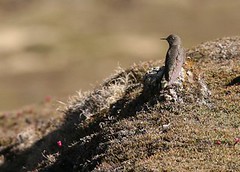The logistics of putting together a small, but involved, expedition sometimes means downtime. Maybe it's permits, transportation, team members, etc. that has you hung up. What to do with all that spare time? Write grant proposals, check. Review grant paperwork, check. Annoy friends with instant messaging, ad nauseum. One could explore Lima, the "Pearl of the Pacific". Seen it, done it.
A couple of weeks prior to departing the US, I discovered an old birding acquaintance from Texas, Steve Gast, was working in Peru. He had posted on the Birding Peru list-serv about seeing White-throated Earthcreeper in Lima Department. White-throated Earthcreeper is a cactus/scrub specialist and inhabits a narrow elevational band that supports this vegetation community. The reported location was about 200 km north of the known range and it's not the easiest identification. On the other hand, Steve is no slouch and he wouldn't stick his neck out with a post like that without being 95% and giving a possible out.
Enter Gibbons to help get the last 5% of uncertainty dispelled.

I would be in town just at the right time to accompany him for an evidence gathering mission. I brought my camera and he brought his recorder. We set out at 5 AM from Lima for the three hour trip up the pacific slope. We passed through some of the driest, barren land on the planet and after climbing in elevation for a few hundred meters cacti began to show up. We got out to stretch our legs and have a look and listen. From the valley wall road we could hear a chorus of cricket chirps bouncing around the valley. Finally Grayish Miner and Cactus Canastero were heard and then seen and we spent some time trying to get a look while we waited for the cloud bank above to lift. After a little playback, Cactus Canasteros were seen. These were new for me and they look a lot like other
Asthenes, not much different at first impression.

We hit a patch of vegetation that was boiling with birdsong: Yellow-billed Tit-Tyrant, White-browed Chat-Tyrant, Mourning Sierra-Finch, Band-tailed Sierra-Finch, Band-tailed Seedeater, Long-tailed Mockingbirds, Bare-eyed Ground-Doves, Collared Warbling-Finch, and Great Inca-Finch come to mind. The Great Inca-Finch is one of five
Incaspiza species, which are all endemic to Peru. How they all managed to get their own restricted ranges would make a nice project if it hasn't already been done.
Onward and upward to the target species we went and sure enough, the second we stepped out of the truck, a rusty blur darted below the road below. We had all the time we needed with these cooperative birds.

The field marks are rusty coverts and secondaries, a broad supercilium, and shorter, stouter bill than U. jelskii. Check, check, check. The song was spot on for the recording we had and it responded by flying right in and perching on a cactus plant.
White-throated Earthcreeper is in the Least Concern category according to the International Union for the Conservation of Nature. The reasons they give for this are the size of the range and the likelihood that the species numbers are greater than 10,000 individuals. Steve's discovery means this species is more widely distributed than previously thought and so it's even less likely to be uplisted to threatened. This species appears to have a strong habitat preference for sparse scrublands with cactus (not sure of the species) and this habitat isn't currently under heavy development pressure.
With all the documentation we needed, we climbed a little further up the mountain and finally called it a day.
So if you're stuck in Lima, go birding.



















